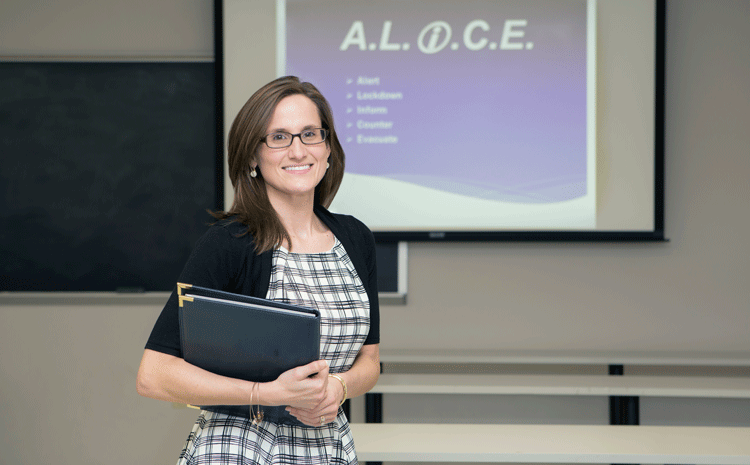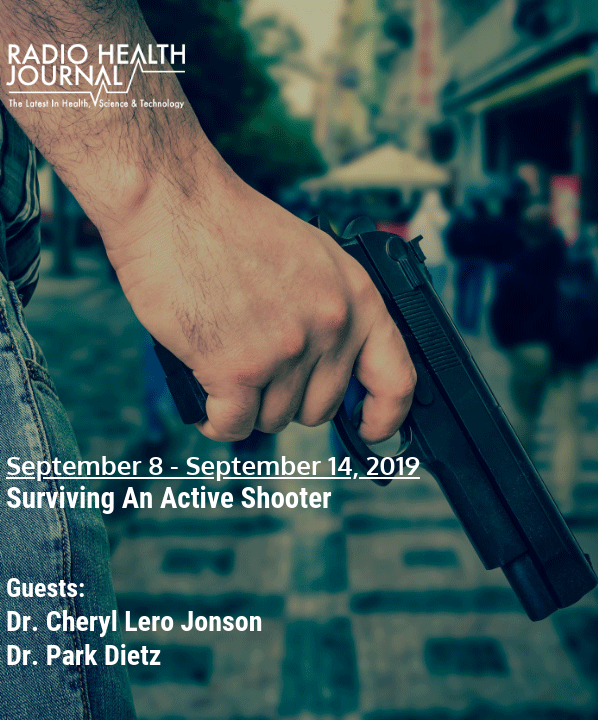
Professor's Research Drives National Discussion on Active Shooter Training
Nov 1, 2019
As Cheryl Jonson explains, there are two ways to respond in a mass shooting situation. There’s the traditional lockdown-hide-and-hope-for-the-best method.
And then there’s ALICE—one of several multi-option approaches being promoted today. It stands for Alert Lockdown Inform Counter and Evacuate, and is similar to Run Hide Fight, Avoid Deny Defend, and other programs that follow the idea that giving people various options for how to respond can save lives.
It’s a theory that Jonson, Associate Professor of Criminal Justice at Xavier University, has not only embraced but extensively studied and written about to the point that she’s become a nationally recognized authority on the subject.
“I began receiving calls right after the Parkland shooting,” Jonson said, referring to the shooting at Marjorie Stoneman Douglas High School in Parkland, Fla., in 2018. “I had written a piece in 2017 about the issue. Then after El Paso and Dayton this year, there was another push for interviews.”
Jonson has been featured in or interviewed for stories in multiple publications and outlets including The New York Times, The Cincinnati Enquirer, the Detroit Free Press, Education Week and This American Life. Her most recent interview was for Radio Health Journal in September, and she’s written articles and opinion pieces for A.M. Best Insurance magazine, Security Management, The Chronicle of Higher Education and The Cincinnati Enquirer.
“Being part of the national conversation makes me become an even more nuanced researcher,” she said. “I’m proud to put Xavier on the map and know my work can potentially make a difference and potentially save a life.”
Jonson’s notoriety began in 2018 when she and a colleague from Northern Kentucky University, where she was on the faculty before coming to Xavier in 2013, published the results of their research in the Journal of School Violence. They concluded that more people survive a mass shooting if they utilize the multi-option training method rather than the traditional lockdown method. Options include evacuating the area, barricading the classroom, and actively resisting by throwing objects at the shooter and/or swarming them.
Jonson had attended a session on school shootings at the Ohio Crime Prevention Association Conference, where she learned about the ALICE training program. She was so intrigued that she signed up for training provided by the ALICE Training Institute.
“And as I was training, I realized no one was studying this method in regards to gathering empirical data,” she said.
She set out to fill the void, utilizing simulations to compare the traditional lockdown method with the multi-option approach to scientifically document which is more effective in saving lives during a mass shooting. The simulations took place in both a classroom and an open area for each of the two methods at 13 training sites across the country over 10 months in 2016 and 2017.
At each site, a veteran male police officer played the part of the shooter, using an Airsoft gun that sounds real but fires plastic pellets. The volunteer victims self-reported what they did and when they got shot. There were 326 volunteer trainees who were trained over two days by the same instructor. In each of the four scenarios, shooting lasted no more than five minutes—reflecting the reality that most mass shootings end in five minutes or less.
Jonson and her colleagues measured the number of people shot and the time to resolution and found in all scenarios a lower percentage of people shot and a quicker resolution using the multi-option method. For example the data showed that the traditional lockdown responses took longer to resolve the shooting incidents than the multi-option responses: In the classroom setting, the average lockdown response took over three minutes to resolve while the ALICE response took only 16 seconds. The results were similar in the open area setting.

And most important, far fewer people were shot in each of the simulations using the multi-option response—and the differences were “statistically significant.” In the classroom setting, 74 percent were shot in the traditional lockdown simulation versus 25 percent in the multi-option simulation. And in the open area simulation, it was 68 percent shot versus only 11 percent.
“These data suggest that when participants used multi-option responses as opposed to the traditional lockdown response, the duration of the simulation was significantly reduced in both classroom and open-area settings” and “a smaller percentage were shot when compared to traditional lockdown techniques,” Jonson and colleagues wrote in their report.
The authors recommend that schools include multi-option training for their staff and students and not rely solely on the traditional lockdown method any more. “The evidence suggests that multi-option strategies have the potential to save lives and should be adopted over traditional lockdown drills,” they concluded.
Jonson is continuing her research at Xavier by exploring different elements of the same issue, including a current study about arming teachers in the classroom and the potential psychological impact of active shooter drills in schools. She incorporates her research into her criminal justice courses at Xavier, not only to teach concepts, research methods and current issues, but to help her students know what to do if someone starts shooting.
She also focuses on prevention and believes the most effective thing anyone can do is to speak up if they suspect someone is at risk of committing a shooting. Because, she says, there is always somebody who knows. “Probably the best way to prevent it is by talking and sharing that information with another.”
Jonson has received hate mail in response to her published writings and interviews, but she takes it all in stride because she believes she’s doing the right thing. Her dream is to no longer have to do this kind of training or research.
“It’s hard and emotionally taxing at times, but it drives me, and if someone can say something I taught them helped them survive the unthinkable or become less fearful and more empowered, then that’s the most rewarding aspect,” she said.
By France Sloat, Office of Marketing and Communications